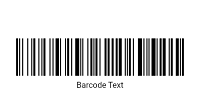The Interleaved 2 of 5 (ITF) barcode is a numeric-only symbology designed for high-density data encoding. Known for its efficiency in encoding numeric data, ITF is widely used in logistics, packaging, and warehousing applications.
ITF was developed in the early 1980s to address the need for a high-density barcode format capable of encoding numeric data efficiently. It is an extension of the 2 of 5 symbology and was designed to improve upon earlier barcode formats by providing a more compact and reliable encoding method.
Technical Specifications
ITF barcodes encode numeric data using interleaved bars and spaces. Each digit is encoded using a combination of bars and spaces, which are interleaved to allow for a higher density of information. Key features of ITF include:
- Numeric Encoding: ITF barcodes encode numeric data (0-9) using pairs of digits, which makes it efficient for applications requiring numeric-only data.
- High Density: The interleaving of bars and spaces allows for a higher density of data compared to other numeric barcodes, making ITF suitable for applications with limited space.
- Start and Stop Characters: ITF includes start and stop characters to define the beginning and end of the data sequence, ensuring accurate scanning and data retrieval.
- Checksum: ITF does not inherently include a checksum character, although it can be used with optional check digit schemes to enhance error detection.
Check Digit Calculation
While ITF barcodes do not require a built-in check digit, it is possible to add a check digit for additional error detection. The check digit is typically calculated using a modulo 10 algorithm:
- Double every second digit from the right.
- Sum all digits, including those that were doubled.
- Calculate the remainder when this sum is divided by 10.
- Subtract the remainder from 10 to get the check digit.
This method helps in verifying the accuracy of the encoded data and reducing scanning errors.
Advantages and Disadvantages
The ITF barcode offers several advantages, including its high-density encoding capability, which allows for compact representation of numeric data. Its design is straightforward, making it relatively easy to implement and scan.
However, ITF is limited to numeric data and does not support alphanumeric characters or special symbols. Its lack of inherent error detection can be a disadvantage, though optional check digit schemes can address this limitation. Additionally, ITF barcodes can be less readable if not printed with high precision, particularly in low-quality print environments.
ITF Applications
ITF barcodes are used in various industries where high-density numeric data encoding is required:
- Logistics and Warehousing: Efficiently encodes tracking numbers and inventory codes, facilitating product tracking and management.
- Packaging: Applied to packaging labels where space is limited and numeric data needs to be encoded compactly.
- Manufacturing: Used for encoding part numbers and production codes, aiding in the tracking of components and products through the manufacturing process.
Comparison with Other Barcode Symbologies
Compared to Code 128, which supports a wider range of characters, ITF is limited to numeric encoding but offers higher data density for numeric sequences. Unlike UPC, which is designed for retail applications and includes fixed-length data, ITF provides more flexibility in data length and density for numeric data. While ITF focuses on high-density numeric encoding, symbologies like EAN-13 and Code 128 offer broader data representation and additional features.
The ITF barcode is a valuable tool for applications requiring high-density numeric data encoding. Its efficiency and compact design make it suitable for logistics, packaging, and manufacturing applications where space is at a premium. While its limitations to numeric data and optional error detection may restrict its use in some scenarios, the ITF barcode's strengths in data density and simplicity have established it as a key format in the barcode technology landscape.


